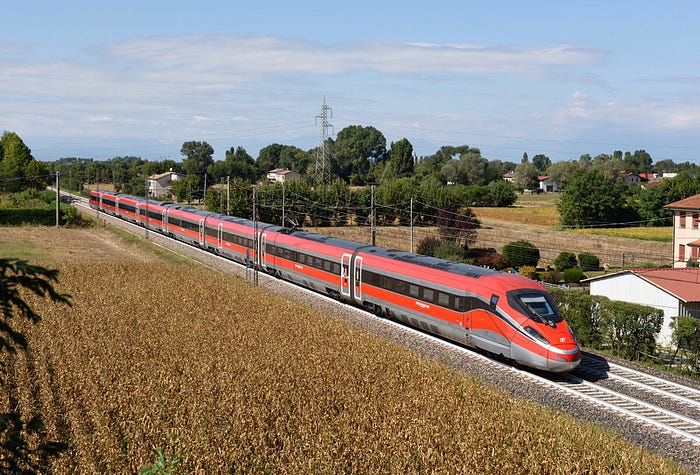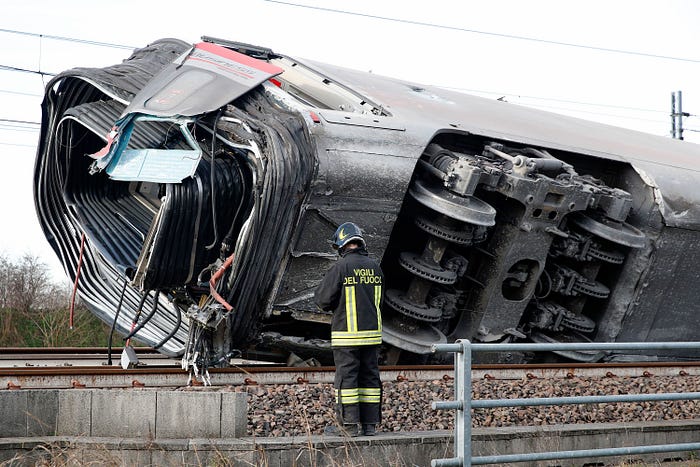
Background
Livraga is a municipality of 2382 people (as of 2021) in northern Italy, located 43km/27mi southeast of Milan and 35km/22mi west of Cremona in the Lombardei-Region (both measurements in linear distance).

Livraga is passed on the northeast by the Milan-Bologna high speed railway, a double-tracked electrified main line opening in sections between 1997 and 2008. The 214.7km/133.5mi line is part of the EU’s Trans-European High Speed Rail Network connecting Berlin and Palermo, allowing trains to go from Milan to Bologna in just over an hour at speeds of up to 300kph/190mph. As an oddity different sections of the line are electrified in AC or DC, requiring multi-system rolling stock that can switch between systems. Livraga doesn’t have a passenger station on the line, but does host a siding and operational station to store rolling stock, allow slower trains to be overtaken and to launch maintenance-trains from. On the day of the accident one of the sidings north of the main tracks was occupied by a row of unspecified parked freight cars

The train involved
Train #9595 is an early morning high speed passenger service from Milan to Salerno, scheduled to depart Milan at 5:10am. On the day of the accident the service is provided by Trenitalia ETR 400 021. Introduced in 2013 the ETR 400 (also called the Frecciarossa 1000) is Italy’s newest high speed train and comes in the form of an eight-car electric multiple unit. Contrasting the preceding ETR 500 the new train no longer has dedicated motor cars, spreading the propulsion system throughout the train underneath the floor. Each unit measures 202m/663ft in length at a weight of 461 metric tons. The trains can reach up to 350kph/217mph, with even more having been achieved in testing, but are limited to 300kph/190mph in regular service. Each unit offers 455 seats along with 2 wheelchair-spots in a two-class configuration and usually runs with two train-drivers and up to 5 attendants. On the day of the accident unit number 400 021 was nearly empty, carrying just 5 crew members (including the drivers) and 28 passengers largely due to the early hour of the connection.

The accident
On the 6th of February 2020 ETR 400 021 is approaching Livraga at approximately 5:30am, travelling at 298kph/185mph. Up ahead were several sets of points connecting the high speed line’s two tracks to several sidings and dead-end tracks at the operational station outside Livraga. First in the path of the train is points-set 5, which had been the subject of in-depth maintenance work the night before when several hydraulic actuators and their control module were replaced. The local dispatch-center informs the crew aboard ETR 400 021 that the points were out of order until further notice, but assures the crew that the points were locked in the “straight ahead” position allowing passage at up to 300kph/190mph. If they were set to turning the speed-limit for the points would have been around 100kph/62mph (some sources claim as little as 60kph/37mph).
Contrary to the dispatch center workers’ assumption the points were not set to “straight ahead” and locked, despite what the signaling system told them. At 5:34am ETR 400 021’s leading car reaches the points at 292kph/181.5mph and is suddenly diverted to the left, derailing the second the wheels are forced to the side. The leading car rips off its train and crashes headlong into the parked freight cars, obliterating the driver’s cab and spinning around 180 degrees. It continues on in reverse for a short distance before falling on it’s side, in the process losing the leading bogie which takes out the wall of a small building while the remains of the leading car come to a rest next to the house. The leading car’s derailment destroyed the points, allowing the rest of the train to proceed in a somewhat straight line instead of being diverted towards the siding as well. The derailed and “headless” train continues for approximately 400m/1312ft before the second (now leading) car falls over and digs itself into the gravel ballast, the added resistance finally bringing the train to a stop. The 2 train drivers in the leading car didn’t stand a chance to survive the impact on the freight cars, and while no one else dies 31 passengers and staff members are injured, two of which severely.

Aftermath
The train loses power as the overhead catenary is destroyed, plunging the interior into darkness. The low occupancy caused by the early departure-time unquestionably saves lives as no passengers were in the leading car and only a single staff-member was in the otherwise empty second car. All but one of the survivors leave the train on their own, and it’s the passengers themselves who notify emergency services of the derailment after figuring out their location by the signage at the nearby buildings and the staff’s knowledge of the route. Within 15 minutes a dozen ambulances, 20 firetrucks and a fleet of police cars arrive at the site, swiftly taking care of the survivors.

Shortly after the accident investigators descend on the site of the accident, tasked with finding out what had, rather literally, thrown the train off course and ended the accident-free era of Italy’s high speed rail infrastructure. Both drivers had been over 50 years old with decades of experience, making a communications-breakdown or inexperience unlikely causes for the accident. With the train showing no pre-existing defects and data-logging showing perfect adherence to speed-limits and instructions the focus of the investigation soon shifts to the tracks rather than the train. The points-set number 5, which was now partially missing, had had several components replaced the prior day, and was taken offline due to an error-message popping up once it was reconnected to the signaling system. Talking to the workers who had worked on the points allowed investigators to find out that the workers would have had to replace a control unit to try and remove the error-message and allow full operation, but that there was no time to organize and replace the control unit during the night. The workers explained that they physically set the points to “straight ahead” and partially disconnected them from the signaling-system to get rid of the error-message, allowing operations to resume at least for trains passing straight through. The signaling system assumed they were set to straight-ahead, and forwarded this status to the dispatch-center. As long as the dispatch center workers didn’t try to shift the points the signaling-system would not notice something was wrong. The workers at the dispatch center understandably trusted the system they worked with every day and informed the drivers of Train #9595, the day’s first service to drive over the points, of the status the system told them.

The process of manually setting and locking points to temporarily re-allow operations was a standard procedure and something done countless times before when points were usable but not fully functional. Fearing a wiring-error to have shifted the set points unintentionally 11 sets of points across Italy are taken out of order as their control modules had been produced in the same batch as the ones from points number 5 at Livraga, allowing their control units to be closely inspected.

The investigation finds that the original error in the control system was caused by a faulty actuator leading to the control unit reporting wrong or invalid settings (the report isn’t quite clear on that distinction), which kept the signaling-system from accepting the points as operational. Two wires inside one of the actuators had been switched during production of the part (the report notes that they broke a seal applied by the manufacturer when opening the component up), which caused one of the points’ actuators to operate opposite to what it was intended to do. This discrepancy is what caused the signaling system to report an error and refuse to accept the points for operation. Unfortunately, the way the wiring was laid out also meant that, regardless of the setting of the points, the position sensor always received the same voltage, always reporting the points as “straight ahead”. Thus the dispatch center couldn’t tell if the workers had actually set the points straight, and the signaling system’s position sensors had been disconnected anyway, putting them out of the equation.

A simple error in the construction of the unit’s hardware, which should have been caught in pre-delivery inspections, essentially was the basic cause of the accident. Two numbered cables connected to the wrong contacts, a fault fixable in minutes. Following the discovery of the faulty construction of the control unit Italian prosecutors officially launch an investigation against Mister Viale, head of Alstom Ferroviaria, the Italian subsidiary of Alstom, a French manufacturer of railway rolling stock and electrical components who delivered the control units.
Since the construction error couldn’t be responsible for the accident on its own Mister Viale found himself alongside the five workers who had replaced the points and prepared them for temporary operation after the error-message presented itself. It was declared that the faulty control unit had necessitated the special procedure to allow limited operation on the line, a procedure which had then been executed improperly leading to the points not remaining in the “straight ahead”-position, assuming they were ever actually set straight ahead. Investigators couldn’t determine if they had been set improperly or not been set at all, in part due to the degree of destruction the points suffered in the derailment. Who exactly moved the points to “straight”, or at least was responsible for them being set that way, could also not be determined with sufficient certainty. None of the workers were put on trial due to that uncertainty, and there is no record of legal consequences against Mister Viale either. Faulty construction of the control module, apparently insufficient factory inspections and a negligent work-ethic had caused the accident, but no single individual could be identified as being sufficiently guilty for legal consequences.

The accident was the first (and as of May 2023 only) lethal accident on Italy’s high speed rail system, which started operation in 2005. Several rail worker unions announced a two-hour strike the day after the accident, demanding that the employers donate the participants’ withheld pay to the relatives of the deceased train drivers, a demand met by the employers. Trenitalia retired the 9595-number from their schedules, renumbering the service to 9505. The train was eventually removed from the site and taken to a maintenance facility by road, it’s assumed that the leading two cars were stripped for spares while the rest of the train may be repaired. What will happen to the cars is unknown, they will either serve as operational spares or perhaps receive two new cars to complete the train again.

_______________________________________________________________
A kind reader is posting the installments on reddit for me, I cannot interact with you there but I will read the feedback and corrections. You can find the post right here.
